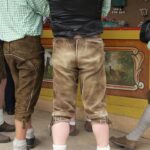
You’ve seen them at Oktoberfest, in Alpine villages, or in beer ads with frothy steins and hearty smiles – but Lederhosen are more than just Bavarian partywear. These iconic leather breeches carry centuries of cultural meaning, craft tradition, and regional pride. Originally worn for toughness and utility, Lederhosen have transformed into one of Germany’s most recognized and proudly worn symbols of identity.
In this guide, we trace the journey of Lederhosen: from rugged peasant roots to global cultural emblem. You’ll learn where they came from, what they signify, how to wear them today, and how they’ve been reimagined in the modern era.
What Are Lederhosen?
Lederhosen literally means “leather trousers.” Traditionally, they are:
- Made of deerskin or goatskin leather
- Cut either short (above the knee) or knee-length
- Worn with suspenders (H-style or Y-style)
- Often embroidered with regional patterns
- Paired with wool socks, checkered shirts, and Haferlschuhe (traditional shoes)
Lederhosen are not just a fashion item – they’re engineered for durability. Leather is ideal for hiking, farm labor, hunting, and horseback riding. Before denim jeans existed, these were Germany’s hard-wearing solution to the daily grind.
Origins: The Workwear of Alpine Farmers and Hunters
The roots of Lederhosen stretch back to the 18th century, especially in Alpine regions of Bavaria, Austria, and South Tyrol. Designed for outdoor labor, these trousers had to withstand rain, rough terrain, and repeated wear.
They became especially associated with:
- Farmers and herders
- Foresters and hunters
- Craftsmen working in rugged conditions
Short Lederhosen allowed for freedom of movement during manual work, while knee-length versions (called Kniebundhosen) offered warmth in colder climates.
How Lederhosen Became a Cultural Symbol
By the 19th century, Lederhosen were still a common sight among rural workers. But urbanization and industrialization began to change fashion, even in the countryside.
The turning point came when Ludwig II of Bavaria and his court started wearing traditional clothing at royal events. This aristocratic approval helped spark a revival of folk costume – known as Tracht – and gave Lederhosen a new cultural value.
By the early 20th century, Tracht clubs (Trachtenvereine) emerged to preserve traditional dress. Lederhosen became part of organized parades, harvest festivals, and patriotic celebrations.
Lederhosen in the 20th Century: Politics, Pride, and Pop Culture
During the early 1900s, Lederhosen were promoted as symbols of German rural purity, masculinity, and pride – ideals exploited during the Nazi era. Post-World War II, Lederhosen briefly fell out of fashion, associated with outdated nationalism.
However, the Oktoberfest boom in the 1960s and 70s revived interest. As beer tourism surged, Lederhosen were reimagined not just as costume, but as celebratory heritage wear.
Today, Germans wear Lederhosen to:
- Celebrate family heritage
- Mark local holidays and events
- Attend beer festivals
- Participate in Tracht parades and dance groups
➡️ Related reading: Dirndl Decoded: The Meaning Behind Germany’s Most Iconic Dress
Types of Lederhosen: More Than One Style
There’s more than one way to wear Lederhosen. Here are the main variations:
- Kurze Lederhosen – Short, above the knee. Most common today.
- Kniebundhosen – Knee-length breeches with a cuff or tie at the bottom.
- Langlederhosen – Full-length leather trousers (less traditional).
Design elements can vary:
- Embroidery on the front flap (drop fly), often featuring edelweiss, stags, or oak leaves.
- Color – brown, black, tan, or even gray depending on the region.
- Suspenders (Hosenträger) – some with embroidered crosspieces.
How to Wear Lederhosen (and Avoid Tourist Traps)
Want to wear Lederhosen at Oktoberfest or a local German event? Great! Just don’t treat them like a Halloween costume. Here’s how to do it right:
✅ Buy real leather. Avoid plastic or polyester blends. ✅ Choose traditional patterns. Don’t go for novelty themes (e.g. pretzels glued on). ✅ Add accessories. Wool socks (Loferl), a proper shirt, and rustic shoes make the look. ✅ Consider tailoring. A good fit is essential. ✅ Ask locals or shop from reputable Tracht stores.
❌ Don’t mix Lederhosen with non-traditional fashion like sneakers or baseball caps. ❌ Avoid costume shops that sell Lederhosen for 20 euros – they won’t last and look cheap.
When Do Germans Wear Lederhosen?
While not everyday wear, Lederhosen are proudly worn during:
- Oktoberfest (Munich and regional variants)
- Volksfeste (local folk festivals)
- Weddings and baptisms (especially in Bavaria)
- Traditional dance performances
- Maypole celebrations
- Heimatfeste (hometown pride festivals)
In Bavaria and Austria, you may even see older men wearing them casually to the Biergarten on Sundays.
Cultural Meaning: Pride, Craftsmanship, and Heritage
Wearing Lederhosen is a statement of:
- Regional identity (especially Bavarian or Alpine)
- Connection to nature (rural, outdoor life)
- Respect for tradition
- Appreciation for craftsmanship (many are handmade)
Well-made Lederhosen can last decades. Some are passed down through families as heirlooms.
Lederhosen in Modern Germany: Stylish or Stale?
Opinions vary. Some younger Germans see Lederhosen as outdated or overly commercialized. Others proudly wear them as part of cultural renewal.
Fashion designers have started to blend traditional cuts with modern details:
- Slimmer silhouettes
- Lighter leather
- Designer stitching or colors
Meanwhile, music acts like LaBrassBanda and voXXclub perform in Lederhosen, giving them a hip, ironic twist.
➡️ Want to go deeper? Modern Tracht: How Germans Are Redefining Traditional Fashion
Where to Buy Real Lederhosen
If you’re serious about getting a pair:
- In Munich: Visit Lodenfrey, Angermaier, or Ludwig & Therese
- Online: Look for traditional Tracht shops, not costume sellers
- Custom-made: Expect to pay €300-€800 for authentic, handmade Lederhosen
Lederhosen vs. Bundhosen: What’s the Difference?
- Lederhosen are usually shorter, made from leather.
- Bundhosen (or Kniebundhosen) are longer and sometimes made of wool or cotton.
Bundhosen are more popular in Austria and the Allgäu region and are seen as slightly more formal.
Not Just Shorts – A Cultural Statement
Lederhosen aren’t going away anytime soon. Whether worn in the mountain pastures of Bavaria or the beer tents of Munich, they remain a proud piece of cultural heritage – one that blends history, identity, and celebration.
Next time you see someone in Lederhosen, don’t think of it as just quirky festival fashion. It’s a story of craftsmanship, community, and continuity stitched in suede.
➡️ Continue exploring:







